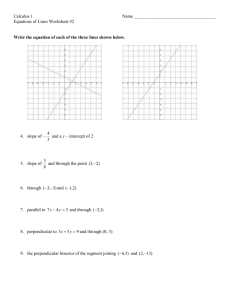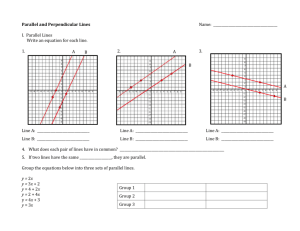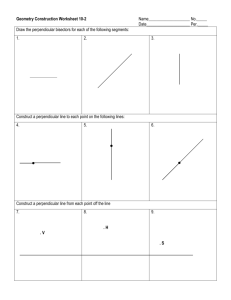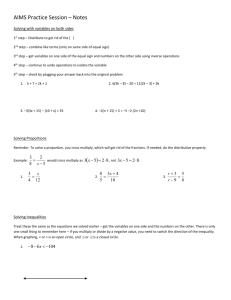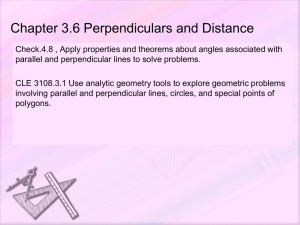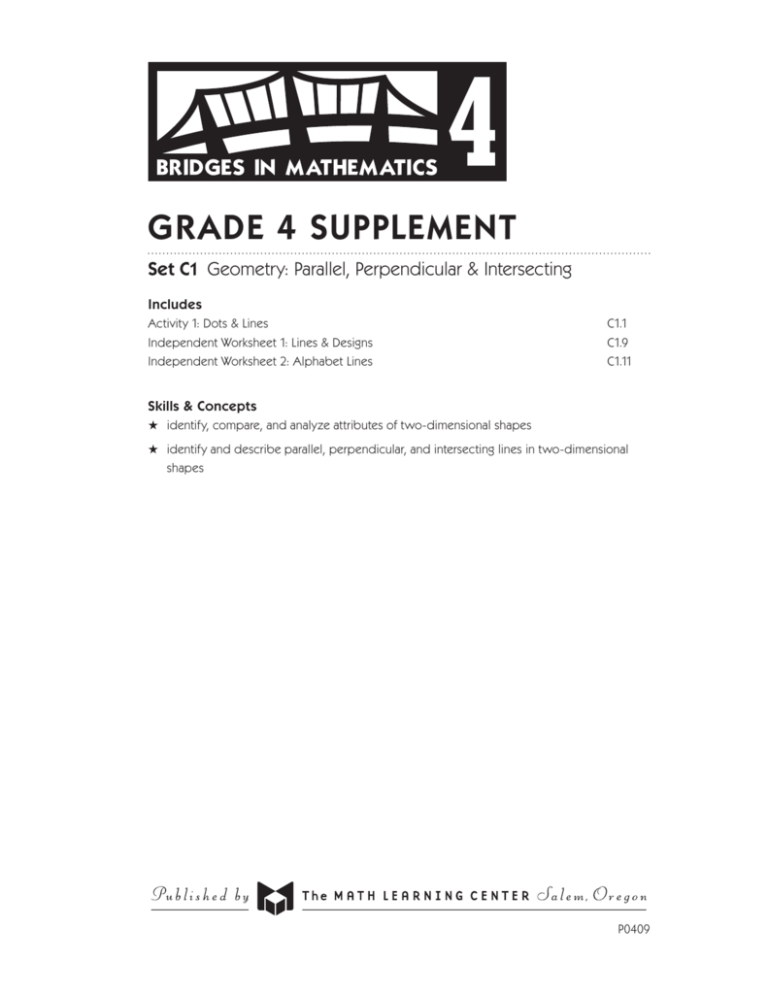
Grade 4 supplement
Set C1 Geometry: Parallel, Perpendicular & Intersecting
Includes
Activity 1: Dots & Lines Independent Worksheet 1: Lines & Designs
Independent Worksheet 2: Alphabet Lines C1.1
C1.9
C1.11
Skills & Concepts
H identify, compare, and analyze attributes of two-dimensional shapes
H identify and describe parallel, perpendicular, and intersecting lines in two-dimensional
shapes
P0409
Bridges in Mathematics Grade 4 Supplement
Set C1 Geometry: Parallel, Perpendicular & Intersecting
The Math Learning Center, PO Box 12929, Salem, Oregon 97309. Tel. 1 800 575–8130.
© 2008 by The Math Learning Center
All rights reserved.
Prepared for publication on Macintosh Desktop Publishing system.
Printed in the United States of America.
P0409
The Math Learning Center grants permission to classroom teachers to reproduce blackline
masters in appropriate quantities for their classroom use.
Bridges in Mathematics is a standards-based K–5 curriculum that provides a unique blend
of concept development and skills practice in the context of problem solving. It incorporates the Number Corner, a collection of daily skill-building activities for students.
The Math Learning Center is a nonprofit organization serving the education community.
Our mission is to inspire and enable individuals to discover and develop their mathematical
confidence and ability. We offer innovative and standards-based professional development,
curriculum, materials, and resources to support learning and teaching. To find out more,
visit us at www.mathlearningcenter.org.
Set C1 Geometry: Parallel, Perpendicular & Intersecting
Set C1 H Activity 1
Activity
Dots & Lines
Overview
You’ll need
Students review the terms parallel, intersecting, and perpendicular, and then play a game with the teacher to practice building and drawing parallel and perpendicular lines.
H Parallel, Perpendicular & Intersecting Lines (page C1.5,
run 1 copy on a transparency)
Skills & Concepts
H Dots & Lines Gameboard (page C1.6, run 1 copy on a
transparency)
H identify, compare, and analyze attributes of twodimensional shapes
H Dots & Lines Game Record Sheet (page C1.7, run a
class set)
H identify and describe parallel, perpendicular, and
intersecting lines in two-dimensional shapes
H single spinner overlay
H black overhead pen
H a piece of paper to mask parts of the overhead
H game markers (16 red and 16 blue)
H 10 red and 10 blue rubber bands
H geoboards and rubber bands (class set)
H a red and a blue colored pencil or marker for each
student
Instructions for Dots & Lines
1. Display the top portion of Parallel, Perpendicular & Intersecting Lines, keeping the rest of the overhead covered for now. Ask students to pair-share any mathematical observations they can make about
the display. Then invite volunteers to share their ideas with the class.
Set C1 Geometry: Parallel, Perpendicular & Intersecting Blackline
Run 1 copy on a transparency.
Parallel, Perpendicular & Intersecting Lines
Parallel Lines are lines that are always the same distance apart. They will never
cross or intersect. Can you explain why? Make 2 parallel lines on your geoboard.
Make 3 lines on your geoboard that are all parallel.
Students There are 2 straight lines up there and they both have arrows at the ends.
I think they’re never going to cross. They’re kind of like train tracks.
Those lines are parallel. I know because you can tell they won’t cross.
2. Reveal the information below the 2 parallel lines on the overhead and read it with the class. Then give
Intersecting
Lines are lines
intersect or
each other.
Make 2 intersecting
each student a geoboard and rubber
bands.
Askthatthem
tocrossbuild
examples
of parallel lines on their boards
lines on your geoboard.
and share them with the people sitting nearest them.
© The Math Learning Center
Bridges in Mathematics Grade 4 Supplement • C1.1
Set C1 Geometry: Parallel, Perpendicular & Intersecting
Activity 1 Dots & Lines (cont.)
3. Repeat steps 1 and 2 until you’ve reviewed all the information on the overhead. Be sure students take
note of the square drawn at the intersection of the perpendicular lines. This is used to indicate that the
two lines are crossing each other at right angles.
Set C1 Geometry: Parallel, Perpendicular & Intersecting Blackline
Run 1 copy on a transparency.
Parallel, Perpendicular & Intersecting Lines
Parallel Lines are lines that are always the same distance apart. They will never
cross or intersect. Can you explain why? Make 2 parallel lines on your geoboard.
Make 3 lines on your geoboard that are all parallel.
Intersecting Lines are lines that intersect or cross each other. Make 2 intersecting
lines on your geoboard.
Perpendicular Lines are special intersecting lines. Where they cross, they form a
right angle. Make 2 lines on your geoboard that are perpendicular.
4. Collect students’ geoboards and bands, and give them each a Dots & Lines Record Sheet. Explain that
you’re going to play a game that will help them remember the terms you just reviewed. They’ll play as
the Red Team against you, and you’ll play as the Blue Team. Have them record the team color assignments on their sheet while you do so on the Dots & Lines Gameboard overhead.
5. Place the spinner overlay on top of the spinner and set a clear geoboard below the spinner. Use your
overhead pen to draw a black line either vertically or horizontally across the board, following one of the
lines of pegs. This is the starting line. Make an asterisk beside the line. Ask students to use a regular pencil to draw a line in the same location on their record sheet and mark it with an asterisk.
6. Explain that you’re going to take the first turn so students can see how to play the game. Spin the
spinner. Read the results with the class, and use a blue rubber band to build a line all the way across the
board, either parallel or perpendicular to the starting line, depending on what the spinner indicated.
Ask students to use a blue pencil or marker to record the results of your turn on their sheets.
Teacher Okay, the spinner landed on “parallel.” That means I have to use a blue rubber band to
make a line that’s parallel to the starting line. I can put it anywhere on the board, as long as it’s
parallel to that line, but I think I’ll put it right beside the starting line.
C1.2 • Bridges in Mathematics Grade 4 Supplement
© The Math Learning Center
Set C1 Geometry: Parallel, Perpendicular & Intersecting
Activity 1 Dots & Lines (cont.)
Set C1 Geometry: Parallel, Perpendicular & Intersecting Blackline
NAME
Mr. R
Run a class set.
DATE
1/26
Dots & Lines Game Record Sheet
Dots & Lines Gameboard
Blue Team ____________________________
Shantell
Set C1 Geometry: Parallel, Perpendicular & Intersecting Blackline
Run 1 copy on a transparency.
The Kids
Red Team _____________________________
Mr. R
Blue Team _____________________________
Game 1
The Kids
Red Team ____________________________
Game 2
*
Parallel Lines
Perpendicular
Lines
Perpendicular
Lines
Parallel Lines
*
Score: Blue __________
Red __________
Game 3
Score: Blue __________
Red __________
Game 4
Score: Blue __________
Red __________
Score: Blue __________
Red __________
7. Before students take their turn, explain that the object of the game is to capture the most small
squares (i.e., squares without any pegs between their corners). Anytime a team forms 1 or more squares
during their move, you’ll mark those squares with game markers in the team’s color. Ask them if they
think they’ll be able to form a square during this turn.
Isaac Nope. If we land on “parallel” there will just be 3 parallel lines in a row on the board. If we
land on “perpendicular” we can build a line across, but it won’t make a square, no matter where we
put it.
Erica Mr. R might be able to make a square on his next turn. I think it’s better to be the first team
to go.
8. Have students take their turn, and then take turns back and forth until no more rubber bands can
be placed and all 16 squares have been formed. If a team spins “parallel” and all the lines parallel to the
starting line have already been made, they lose that turn.
It’s possible to form more than 1 square during a single move, and students may get more strategic
about where they’re placing their rubber bands as the game proceeds. Be sure to mark the squares with
game markers and have students use colored dots to mark them on their record sheets. The sample record sheet on the next page shows how the game might look midway through and again at the end.
© The Math Learning Center
Bridges in Mathematics Grade 4 Supplement • C1.3
Set C1 Geometry: Parallel, Perpendicular & Intersecting
Activity 1 Dots & Lines (cont.)
Set C1 Geometry: Parallel, Perpendicular & Intersecting Blackline
NAME
Shantell
Run a class set.
DATE
1/26
Dots & Lines Game Record Sheet
Mr. R
Blue Team _____________________________
Game 1
Score: Blue __________
Game 3
Red __________
NAME
Shantell
Run a class set.
DATE
1/26
Dots & Lines Game Record Sheet
The Kids
Red Team ____________________________
Score: Blue __________
Game 4
Mr. R
Blue Team _____________________________
Game 1
Game 2
*
Set C1 Geometry: Parallel, Perpendicular & Intersecting Blackline
Red __________
*
10
Score: Blue __________
Game 3
The Kids
Red Team ____________________________
Game 2
6
Red __________
Score: Blue __________
Red __________
Game 4
Students Mr. R really lucked out on that last move.
Too bad he didn’t get “parallel” that last time. Then it would have been our turn again, and if we’d
gotten “perpendicular” we would have won.
Can we play it again?
9. Dots & Lines goes very quickly, and students have room to record the results of 4 games. Take turns
with the class to be the starting team. The team that starts first gets to erase the starting line and draw a
Score: Blue __________ Red __________
Score: Blue __________ Red __________
Score: Blue __________ Red __________
Score: Blue __________ Red __________
new one
anywhere they want
on the board.
Here are a few important rules to remember about Dots & Lines:
• The starting line has to go all the way across the board, either horizontally or vertically.
• A rubber band can be placed anywhere on the board, as long as it’s oriented correctly with respect to
the starting line.
• Rubber bands have to go all the way across the board.
• The object of the game is to capture the most small squares; squares that have pegs between corners
are not allowed.
• Remember to mark every square a team forms on a given turn.
• Count the squares captured by each team at the end of the game to determine the winner.
Extensions
• If your students enjoy this game, run another set of the record sheets and play it again. A single game
makes a nice sponge activity, and you can have students save their record sheets for repeated use
over the course of a week.
• Challenge students to explain why there are no intersecting lines that are not perpendicular in this game.
• Leave the materials out, along with extra copies of the record sheet so students can play the game
with each other at the overhead during their free time.
Independent Worksheet
See Set C1 Independent Worksheets 1 and 2 for more practice identifying and describing parallel, perpendicular, and intersecting lines using concrete objects and pictorial models.
C1.4 • Bridges in Mathematics Grade 4 Supplement
© The Math Learning Center
Set C1 Geometry: Parallel, Perpendicular & Intersecting Blackline Run 1 copy on a transparency.
Parallel, Perpendicular & Intersecting Lines
Parallel Lines are lines that are always the same distance apart. They will never
cross or intersect. Can you explain why? Make 2 parallel lines on your geoboard.
Make 3 lines on your geoboard that are all parallel.
Intersecting Lines are lines that intersect or cross each other. Make 2 intersecting
lines on your geoboard.
Perpendicular Lines are special intersecting lines. Where they cross, they form a
right angle. Make 2 lines on your geoboard that are perpendicular.
© The Math Learning Center
Bridges in Mathematics Grade 4 Supplement • C1.5
Set C1 Geometry: Parallel, Perpendicular & Intersecting Blackline Run 1 copy on a transparency.
Dots & Lines Gameboard
Blue Team ____________________________
Red Team _____________________________
Parallel Lines
Perpendicular
Lines
Perpendicular
Lines
Parallel Lines
C1.6 • Bridges in Mathematics Grade 4 Supplement
© The Math Learning Center
Set C1 Geometry: Parallel, Perpendicular & Intersecting Blackline Run a class set.
name
date
Dots & Lines Game Record Sheet
Blue Team _____________________________
Game 1
Score: Blue __________
Game 2
Red __________
Game 3
Score: Blue __________
© The Math Learning Center
Red Team ____________________________
Score: Blue __________
Red __________
Game 4
Red __________
Score: Blue __________
Red __________
Bridges in Mathematics Grade 4 Supplement • C1.7
C1.8 • Bridges in Mathematics Grade 4 Supplement
© The Math Learning Center
Set C1 Geometry: Parallel, Perpendicular & Intersecting Blackline Use anytime after Set C1 Activity 1. Run a class set.
name
date
Set C1 H Independent Worksheet 1
Independent Worksheet
Lines & Designs
1
Fill in the bubbles in front of the words that describes each set of lines below.
Then explain your answer. How do you know? The first one is done for you.
example
a
intersecting lines
intersecting lines
parallel lines
parallel lines
perpendicular lines
perpendicular lines
How do you know?
How do you know?
I know these are intersecting lines because they
cross. I know they’re not perpendicular because
they don’t cross at right angles.
b
c
intersecting lines
intersecting lines
parallel lines
parallel lines
perpendicular lines
perpendicular lines
How do you know?
How do you know?
(Continued on back.)
© The Math Learning Center
Bridges in Mathematics Grade 4 Supplement • C1.9
Set C1 Geometry: Parallel, Perpendicular & Intersecting Blackline Run a class set.
Independent Worksheet 1 Lines & Designs (cont.)
2
Get a geoboard and some colored rubber bands. Use them to make each of the
designs described below. Then use regular and colored pencils to record your
work on this sheet.
example
Make a design with 6 gray
parallel lines.
a
b
c
Make a horizontal blue line all
the way across the board. Then add 4
green lines that are all perpendicular
to the blue line.
C1.10 • Bridges in Mathematics Grade 4 Supplement
Make a design with 6 red intersecting lines.
Make a yellow diagonal line all the
way across the board. Then add 4 blue
lines that intersect with the yellow line.
© The Math Learning Center
Set C1 Geometry: Parallel, Perpendicular & Intersecting Blackline Use anytime after Set C1 Activity 1. Run a class set.
name
date
Set C1 H Independent Worksheet 2
Independent Worksheet
Alphabet Lines
1
The kids in Mrs. Odell’s fourth grade were learning about different kinds of lines.
Hector made the letter H on his geoboard and said, “Hey look! These 2 lines I’m
pointing to are parallel.”
a
Get a geoboard and some colored rubber bands. On your geoboard, make 4
other capital letters that have 2 or 3 parallel lines in them. Use red rubber bands
to make the lines that are parallel to each other. Use a ruler and colored pencils
to record your work below. Show the parallel lines in red.
b
How do you know for sure that the lines you made in red are parallel?
(Continued on back.)
© The Math Learning Center
Bridges in Mathematics Grade 4 Supplement • C1.11
Set C1 Geometry: Parallel, Perpendicular & Intersecting Blackline Run a class set.
Independent Worksheet 2 Alphabet Lines (cont.)
2
Then Lani said, “The two lines in the first letter of my name are perpendicular. You can see that they meet at a right angle on the board.”
On your geoboard, make 4 other capital letters that have perpendicular lines. Record your work below. Draw arrows to show where the lines meet at right angles.
3
Then Xavier said, “I think the first letter of my name has intersecting lines.”
a
Do you agree with him? Why or why not? If you do, draw an arrow to show
where the 2 lines intersect.
(Continued on next page.)
C1.12 • Bridges in Mathematics Grade 4 Supplement
© The Math Learning Center
Set C1 Geometry: Parallel, Perpendicular & Intersecting Blackline Run a class set.
name
date
Independent Worksheet 2 Alphabet Lines (cont.)
3b
Circle the letter that has 2 intersecting lines.
c
j
x
i
s
l
4
Write the first letter of your first name in this box. Label it to show any lines
that are parallel, perpendicular, or intersecting. If the first letter of your first
name is completely curved (like O or C), choose a different letter in your first or
last name that has straight lines.
challenge
5
Circle True or False to show which statements below correctly descibe these lines.
a The two lines above are parallel.
bThe two lines above are pependicular.
c The two lines above are interesecting.
True
False
True
False
True
False
6
Two lines that are not parallel and not perpendicular are called oblique lines.
Circle all the pairs of oblique lines below.
© The Math Learning Center
Bridges in Mathematics Grade 4 Supplement • C1.13
C1.14 • Bridges in Mathematics Grade 4 Supplement
© The Math Learning Center


